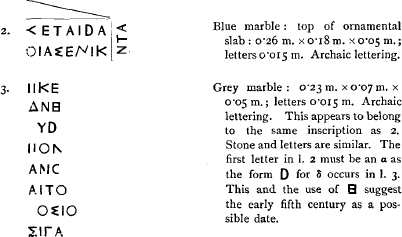Laconia
II.—Excavations at Sparta, 1906: § 4.—The Great Altar near the Eurotas
-
- Published online by Cambridge University Press:
- 18 October 2013, pp. 295-302
-
- Article
-
- You have access
- Export citation
II.—Excavations at Sparta, 1906: § 5.—The Sanctuary of Artemis Orthia
-
- Published online by Cambridge University Press:
- 18 October 2013, pp. 303-317
-
- Article
- Export citation
II.—Excavations at Sparta, 1906: § 6.—Remains of the Archaic Greek Period
-
- Published online by Cambridge University Press:
- 18 October 2013, pp. 318-330
-
- Article
-
- You have access
- Export citation
II.—Excavations at Sparta, 1906: § 7.—The Cult of Orthia as Illustrated by the Finds
-
- Published online by Cambridge University Press:
- 18 October 2013, pp. 331-343
-
- Article
-
- You have access
- Export citation
II.—Excavations at Sparta, 1906: § 8.—The Stamped Tiles
-
- Published online by Cambridge University Press:
- 18 October 2013, pp. 344-350
-
- Article
-
- You have access
- Export citation
II—Excavations at Sparta, 1906: § 9.—Inscriptions from the Artemisium
-
- Published online by Cambridge University Press:
- 18 October 2013, pp. 351-393
-
- Article
-
- You have access
- Export citation
II.—Excavations at Sparta. 1906: § 10.—The Theatre
-
- Published online by Cambridge University Press:
- 18 October 2013, pp. 394-406
-
- Article
-
- You have access
- Export citation
II—Excavations at Sparta, 1906: § 11.—The Roman Baths. (Arapissa.)
-
- Published online by Cambridge University Press:
- 18 October 2013, pp. 407-414
-
- Article
-
- You have access
- Export citation
II.—Excavations at Sparta, 1906: § 12.—The Roman Stoa and the later Fortifications
-
- Published online by Cambridge University Press:
- 18 October 2013, pp. 415-430
-
- Article
-
- You have access
- Export citation
II.—Excavations at Sparta, 1906: § 13.—Topographical Conclusions
-
- Published online by Cambridge University Press:
- 18 October 2013, pp. 431-439
-
- Article
-
- You have access
- Export citation
II—Excavations at Sparta, 1906: § 14.—Inscriptions from the Altar, the Acropolis, and other Sites
-
- Published online by Cambridge University Press:
- 18 October 2013, pp. 440-479
-
- Article
-
- You have access
- Export citation
Meeting Report
Annual Meeting of Subscribers
-
- Published online by Cambridge University Press:
- 18 October 2013, pp. 481-494
-
- Article
- Export citation
Other
Income and Expenditure, 1905–1906
-
- Published online by Cambridge University Press:
- 18 October 2013, pp. 495-496
-
- Article
- Export citation
Donations and Subscriptions, 1905–1906
-
- Published online by Cambridge University Press:
- 18 October 2013, pp. 497-501
-
- Article
- Export citation
List of Subscribers
-
- Published online by Cambridge University Press:
- 18 October 2013, pp. 502-507
-
- Article
- Export citation
List of Directors, Honorary Students, Students, and Associates
-
- Published online by Cambridge University Press:
- 18 October 2013, pp. 508-515
-
- Article
- Export citation
Methods of Work and Teaching
-
- Published online by Cambridge University Press:
- 18 October 2013, p. 516
-
- Article
- Export citation
Rules and Regulations of the British School at Athens
-
- Published online by Cambridge University Press:
- 18 October 2013, pp. 517-520
-
- Article
- Export citation
Index
-
- Published online by Cambridge University Press:
- 18 October 2013, pp. 521-523
-
- Article
- Export citation
Front matter
ATH volume 12 Cover and Front matter
-
- Published online by Cambridge University Press:
- 18 October 2013, pp. f1-f12
-
- Article
-
- You have access
- Export citation


